Kyocera FS-1025MFP, FS-1320MFP, FS-1120MFP, FS-1325MFP, FS-1125MFP User Guide
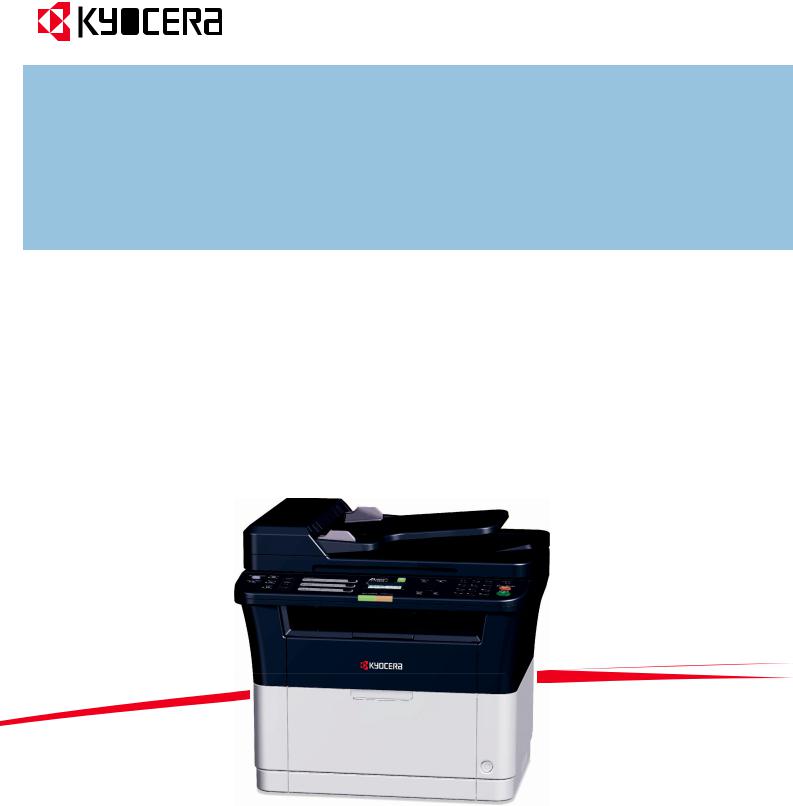
FS-1025MFP FS-1320MFP FS-1120MFP FS-1325MFP FS-1125MFP
OPERATION GUIDE
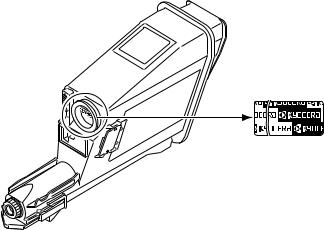
This Operation Guide is for models FS-1025MFP, FS-1120MFP, FS-1125MFP, FS-1320MFP and FS-1325MFP.
This Operation Guide is intended to help you operate the machine correctly, perform routine maintenance and take a simple troubleshooting action as necessary, so that you can always use the machine in good condition.
We recommend the use of our own brand supplies. We will not be liable for any damage caused by the use of third party supplies in this machine.
A label shown in the illustration assures that the supplies are our own brand.
Included Guides
The following guides are supplied with the machine. Refer to them as necessary.
Quick Installation Guide |
Describes the procedures for installation of the machine. |
|
|
Safety Guide |
Provides safety and cautionary information for the installation and use of |
|
the machine. Be sure to read this guide before using the machine. |
|
|
Safety Guide |
Describes the machine installation space, cautionary space, and other |
(FS-1020MFP/FS-1025MFP/FS-1120MFP/ |
information. Be sure to read this guide before using the machine. |
FS-1125MFP/FS-1220MFP/FS-1320MFP/ |
|
FS-1325MFP) |
|
Product Library disc |
|
|
|
Operation Guide (This Guide) |
Describes how to load paper, basic copy, print and scan operations, and |
|
troubleshooting. |
|
|
KYOCERA Client Tool User Guide |
Describes how to use KYOCERA Client Tool. KYOCERA Client Tool is a |
|
software program that is installed on your computer to enable you to |
|
configure machine settings. |
|
|
Printer Driver User Guide |
Describes how to install the printer driver and use printer functionality. |
|
|
KYOCERA Net Viewer User Guide |
Describes how to monitor the network printing system with KYOCERA Net |
|
Viewer. |
|
|
FAX Driver User Guide |
Describes how to install and use the FAX Driver in order to use FAX Driver |
|
functionality. |
|
|

Contents
1 |
Machine Parts ................................................................................................................................................ |
1-1 |
|
Front Machine Components ......................................................................................................................... |
1-2 |
|
Rear Machine Components .......................................................................................................................... |
1-3 |
|
Operation Panel ............................................................................................................................................. |
1-4 |
2 |
Preparation ..................................................................................................................................................... |
2-1 |
|
Connections ................................................................................................................................................... |
2-2 |
|
Loading Paper ................................................................................................................................................ |
2-5 |
|
Loading Originals ........................................................................................................................................ |
2-18 |
|
Installing and Uninstalling Drivers and Utilities ....................................................................................... |
2-20 |
|
Machine Settings ......................................................................................................................................... |
2-26 |
|
Configuration ............................................................................................................................................... |
2-48 |
|
Printing the Status Page ............................................................................................................................. |
2-58 |
3 |
Copying .......................................................................................................................................................... |
3-1 |
|
Basic Operation ............................................................................................................................................. |
3-2 |
|
Manual Duplex ............................................................................................................................................... |
3-3 |
|
Using Programs ............................................................................................................................................. |
3-5 |
|
Copying Functions ........................................................................................................................................ |
3-6 |
|
ID Card Copy ................................................................................................................................................ |
3-13 |
4 |
Printing ........................................................................................................................................................... |
4-1 |
|
Printing from Application Software ............................................................................................................. |
4-2 |
|
About GX Driver ............................................................................................................................................. |
4-2 |
|
Manual Feed (FS-1025MFP, FS-1125MFP and FS-1325MFP) ..................................................................... |
4-3 |
|
Manual Duplex (FS-1120MFP and FS-1320MFP only) ................................................................................ |
4-4 |
|
Print Box ......................................................................................................................................................... |
4-6 |
|
Changing the Default Printer Driver Settings (Windows 7 for example) .................................................. |
4-8 |
5 |
Scanning ........................................................................................................................................................ |
5-1 |
|
Push Scan ...................................................................................................................................................... |
5-2 |
|
Using Programs ............................................................................................................................................. |
5-3 |
|
Quick Scan (Scan to PDF/Scan to Email/Scan to Folder) .......................................................................... |
5-4 |
|
Scanning using TWAIN/WIA ......................................................................................................................... |
5-5 |
6 Default Setting (System Menu) ..................................................................................................................... |
6-1 |
|
|
Default Setting (System Menu) ..................................................................................................................... |
6-2 |
|
System Menu Settings .................................................................................................................................. |
6-3 |
|
Administrator ID ............................................................................................................................................ |
6-6 |
7 |
FAX Operations ............................................................................................................................................. |
7-1 |
|
Before Using the Fax Machine ..................................................................................................................... |
7-2 |
|
Entering the Destination ............................................................................................................................... |
7-7 |
|
Sending Faxes ............................................................................................................................................. |
7-12 |
|
Receiving Faxes .......................................................................................................................................... |
7-21 |
|
Printing Communication Reports .............................................................................................................. |
7-23 |
|
Fax Settings ................................................................................................................................................. |
7-24 |
|
Sending Faxes from PC .............................................................................................................................. |
7-37 |
8 |
Maintenance ................................................................................................................................................... |
8-1 |
|
General Information ...................................................................................................................................... |
8-2 |
|
Toner Container Replacement ..................................................................................................................... |
8-2 |
|
Maintenance Kit Replacement ...................................................................................................................... |
8-5 |
i

|
Cleaning the Machine ................................................................................................................................... |
8-5 |
|
Maintenance Menu ........................................................................................................................................ |
8-8 |
|
Prolonged Non-Use and Moving of the Machine ....................................................................................... |
8-9 |
9 |
Troubleshooting ............................................................................................................................................ |
9-1 |
|
Solving Malfunctions .................................................................................................................................... |
9-2 |
|
Error Messages ............................................................................................................................................. |
9-8 |
|
FAX Error Code List .................................................................................................................................... |
9-12 |
|
Clearing Paper Jams .................................................................................................................................. |
9-14 |
10 |
Appendix ...................................................................................................................................................... |
10-1 |
|
Character Entry Method ............................................................................................................................. |
10-2 |
|
Specifications .............................................................................................................................................. |
10-5 |
Index ............................................................................................................................................................... |
Index-1 |
|
ii
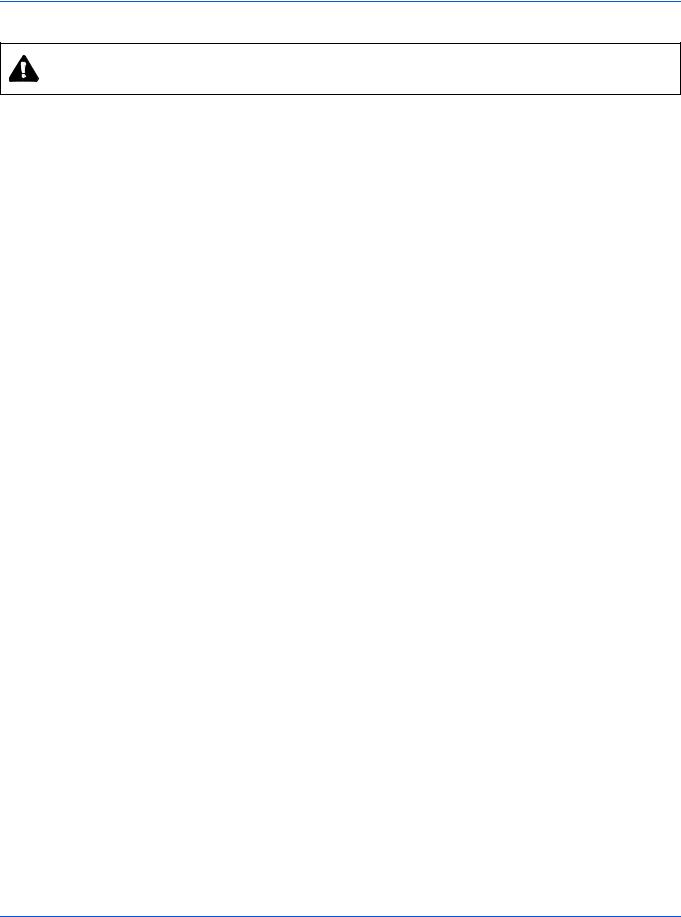
Legal and Safety Information
CAUTION NO LIABILITY IS ASSUMED FOR ANY DAMAGE CAUSED BY IMPROPER INSTALLATION.
Notice
The information in this guide is subject to change without notification. Additional pages may be inserted in future editions. The user is asked to excuse any technical inaccuracies or typographical errors in the present edition.
No responsibility is assumed if accidents occur while the user is following the instructions in this guide. No responsibility is assumed for defects in the machine's firmware (contents of its read-only memory).
This guide, and any copyrightable subject matter sold or provided with or in connection with the sale of the machine, are protected by copyright. All rights are reserved. Copying or other reproduction of all or part of this guide, or any copyrightable subject matter without the prior written consent of KYOCERA Document Solutions Inc. is prohibited. Any copies made of all or part of this guide, or any copyrightable subject must contain the same copyright notice as the material from which the copying is done.
Regarding Tradenames
Adobe Acrobat, and Flash are registered trademarks of Adobe Systems Incorporated. Macintosh and Mac OS are trademarks of Apple Inc., registered in the U.S. and other countries.
Microsoft, MS-DOS, and Windows are registered trademarks of Microsoft Corporation in the U.S.A. and/or other countries. ENERGY STAR is a U.S. registered mark.
All other brand and product names are registered trademarks or trademarks of their respective companies.
iii

Compliance and Conformity
This equipment has been tested and found to comply with the limits for a Class B digital device, pursuant to Part 15 of the FCC Rules. These limits are designed to provide reasonable protection against harmful interference in a residential installation. This equipment generates, uses and can radiate radio frequency energy and, if not installed and used in accordance with the instructions, may cause harmful interference to radio communications. However, there is no guarantee that interference will not occur in a particular installation. If this equipment does cause harmful interference to radio or television reception, which can be determined by turning the equipment off and on, the user is encouraged to try to correct the interference by one or more of the following measures:
•Reorient or relocate the receiving antenna.
•Increase the separation between the equipment and receiver.
•Connect the equipment into an outlet on a circuit different from that to which the receiver is connected.
•Consult the dealer or an experienced radio/TV technician for help.
•The use of a non-shielded interface cable with the referenced device is prohibited.
CAUTION — The changes or modifications not expressly approved by the party responsible for compliance could void the user’s authority to operate the equipment.
This device complies with Part 15 of FCC Rules.
Operation is subject to the following two conditions; (1) this device may not cause interference, and (2) this device must accept any interference, including interference that may cause undesired operation of the device.
* The above warning is valid only in the United States of America.
Interface connectors
IMPORTANT Be sure to power off the machine before connecting or disconnecting an interface cable. For protection against static electricity discharge to the machine's internal electronics through the interface connector(s), cover any interface connector that is not in use with the protective cap supplied.
 Note Use shielded interface cables.
Note Use shielded interface cables.
CDRH Regulations
The Center for Devices and Radiological Health (CDRH) of the U.S. Food and Drug Administration implemented regulations for laser products on August 2, 1976. These regulations apply to laser products manufactured after August 1, 1976. Compliance is mandatory for products marketed in the United States. A label indicating compliance with the CDRH regulations must be attached to laser products marketed in the United States.
Canadian Department of Communications Compliance Statement
This Class B digital apparatus complies with Canadian ICES-003.
Avis de conformité aux normes du ministère des Communications du Canada
Cet appareil numérique de la classe B est conforme à la norme NMB-003 du Canada.
iv

Safety Instructions Regarding the Disconnection of Power
Caution: The power plug is the main isolation device! Other switches on the equipment are only functional switches and are not suitable for isolating the equipment from the power source.
VORSICHT: Der Netzstecker ist die Hauptisoliervorrichtung! Die anderen Schalter auf dem Gerät sind nur Funktionsschalter und können nicht verwendet werden, um den Stromfluß im Gerät zu unterbrechen.
Energy Saving Control Function
To reduce energy consumption while in a waiting state, the device comes equipped with an energy saving control function for switching to Sleep Mode as well as Power Off Mode where power consumption is automatically reduced to a minimum after a certain amount of time elapses since the device was last used.
Sleep Mode
The device automatically enters Sleep Mode when approximately 1 minute has passed since the device was last used. The amount of time of no activity that must pass before Sleep Mode is activated may be lengthened by changing the Auto sleep setting. For details, refer to Device Defaults Tab on page 2-50.
Power Off Mode
The device automatically turns its power off when 1 hour has passed since the device was last used. The amount of time of no activity that must pass before Power Off Mode is activated may be lengthened by changing the Power Off Timer setting. For details, refer to Device Defaults Tab on page 2-50.
In case of not using the machine for an extended period of time
CAUTION If this machine will be left unused for an extended period (e.g. overnight), turn it off at the power switch. If the machine will not be used for an even longer period of time (e.g. vacation), remove the power plug from the outlet as a safety precaution. If using FS-1120MFP/FS-1125MFP/FS-1320MFP/ FS-1325MFP, note that turning the machine off at the power switch disables fax transmission and reception.
CAUTION Remove paper from the cassettes and seal it in the paper storage bag to protect it from humidity.
Duplex Printing (FS-1025MFP, FS-1125MFP and FS-1325MFP)
This machine includes duplex printing as a standard function. For example, by printing two single-sided originals onto a single sheet of paper as a duplex printing, it is possible to lower the amount of paper used.
Printing in duplex mode reduces paper consumption and contributes to the conservation of forest resources. Duplex mode also reduces the amount of paper that must be purchased, and thereby reduces cost. It is recommended that machines capable of duplex printing be set to use duplex mode by default.
Resource Saving - Paper
For the preservation and sustainable use of forest resources, it is recommended that recycled as well as virgin paper certified under environmental stewardship initiatives or carrying recognised ecolabels, which meet EN 12281:2002*1 or an equivalent quality standard, be used.
This machine also supports printing on 64 g/m² paper. Using such paper containing less raw materials can lead to further saving of forest resources.
*1: EN12281:2002 "Printing and business paper - Requirements for copy paper for dry toner imaging processes" Your sales or service representative can provide information about recommended paper types.
v

Environmental benefits of "Power Management"
To reduce power consumption when idle, this machine is equipped with a power management function that automatically activates energy-saving mode when the machine is idle for a certain period of time. Although it takes the machine a slight amount of time to return to READY mode when in energy-saving mode, a significant reduction in energy consumption is possible.
It is recommended that the machine be used with the activation time for energy-saving mode set to the default setting.
Energy Star (ENERGY STAR®)
We have determined as a company participating in ENERGY STAR® that this product has earned the ENERGY STAR®.
ENERGY STAR® is a voluntary energy efficiency program with the goal of developing and promoting the use of products with high energy efficiency in order to help prevent global warming. By purchasing ENERGY STAR® qualified products, customers can help reduce emissions of greenhouse gases during product use and cut energy-related costs.
Legal Restriction on Copying/Scanning
It may be prohibited to copy/scan copyrighted material without permission of the copyright owner.
Copying/Scanning the following items is prohibited and may be penalized by law. It may not be limited to these items. Do not knowingly copy/scan the items that are not to be copied/scanned.
•Paper money
•Bank note
•Securities
•Stamp
•Passport
•Certificate
Local laws and regulations may prohibit or restrict copying/scanning of other items not mentioned above.
vi

FCC PART 68 REQUIREMENTS
1This equipment complies with Part 68 of the FCC rules and the requirements adopted by the ACTA. On the rear side of the equipment to install Assembly Board is a label that contains, among other information, a product identifier in the format US:AAAEQ##TXXXX. If requested, this number must be provided to the telephone company.
2This equipment connects to the network via USOC RJ11C.
3A plug and jack used to connect this equipment to the premises wiring and telephone network must comply with the applicable FCC Part 68 rules and requirements adopted by the ACTA. A compliant telephone cord and modular plug is provided with this product. It is designed to be connected to a compatible modular jack that is also compliant. See installation instructions for details.
4The REN is used to determine the number of devices that may be connected to a telephone line. Excessive RENs on a telephone line may result in the devices not ringing in response to an incoming call. In most but not all areas, the sum of RENs should not exceed five (5.0). To be certain of the number of devices that may be connected to a line, as determined by the total RENs, contact the local telephone company. For products approved after July 23, 2001, the REN for this product is part of the product identifier that has the format US:AAAEQ##TXXXX. The digits represented by ## are the REN without a decimal point (e.g., 03 is a REN of 0.3). For earlier products, the REN is separately shown on the label.
5If this equipment causes harm to the telephone network, the telephone company will notify you in advance that temporary discontinuance of service may be required. But if advance notice isn't practical, the telephone company will notify the customer as soon as possible. Also, you will be advised of your right to file a complaint with the FCC if you believe it is necessary.
6The telephone company may make changes in its facilities, equipment, operations or procedures that could affect the operation of the equipment. If this happens the telephone company will provide advance notice in order for you to make necessary modifications to maintain uninterrupted service.
7If trouble is experienced with this equipment, please contact the following company for repair and (or) warranty information:
KYOCERA Document Solutions America, Inc.
225 Sand Road,
Fairfield, New Jersey 07004-0008, USA
Phone: +1-973-808-8444
Fax: +1-973-882-6000
If the equipment is causing harm to the telephone network, the telephone company may request that you disconnect the equipment until the problem is resolved.
8This equipment cannot be used on public coin service provided by the telephone company. Connection to Party line service is subject to state tariffs. Contact the state public utility commission, public service commission or corporation commission for information.
9If your home has specially wired alarm equipment connected to the telephone line, ensure the installation of this equipment does not disable your alarm equipment. If you have questions about what will disable alarm equipment, consult your telephone company or a qualified installer.
10The Telephone Consumer Protection Act of 1991 makes it unlawful for any person to use a computer or other electronic device, including FAX machines, to send any message unless such message clearly contains in a margin at the top or bottom of each transmitted page or on the first page of the transmission, the date and time it is sent and an identification of the business or other entity, or other individual sending the message and the telephone number of the sending machine or such business, other entity, or individual. (The telephone number provided may not be a 900 number or any other number for which charges exceed local or long-distance transmission charges.)
In order to program this information into your FAX machine, you should complete the following steps: (Insure that it will be transmitted, see Local FAX Name on page 7-3, Local FAX Number on page 7-4, TTI (Transmit Terminal Identification) on page 7-3 and Setting Date and Time on page 7-2.)
vii

IMPORTANT SAFETY INSTRUCTIONS
When using your telephone equipment, basic safety precautions should always be followed to reduce the risk of fire, electric shock and injury to persons, including the following:
CAUTION: To reduce the risk of fire, use only No.26 AWG or larger UL listed or CSA certified telecommunication line cord.
1Do not use this product near water, for example, near a bath tub, wash bowl, kitchen sink or laundry tub, in a wet basement or near a swimming pool.
2Avoid using a telephone (other than a cordless type) during an electrical storm. There may be a remote risk of electric shock from lightning.
3Do not use the telephone to report a gas leak in the vicinity of the leak.
4Use only the power cord and batteries indicated in this manual. Do not dispose of batteries in a fire. They may explode. Check with local codes for possible special disposal instructions.
SAVE THESE INSTRUCTIONS
IMPORTANTES MESURES DE SECURITE
Certaines mesures de sécurité doivent être prises pendant l'utilisation de matériel téléphonique afin de réduire les risques d'incendie, de choc électrique et de blessures. En voici quelques unes:
1Ne pas utiliser l'appareil près de l'eau, p. ex., près d'une baignoire, d'un lavabo, d'un évier de cuisine, d'un bac à laver, dans un sous-sol humide ou près d'une piscine.
2Eviter d'utiliser le téléphone (sauf s'il s'agit d'un appareil sans fil) pendant un orage électrique. Ceci peut présenter un risque de choc électrique causé par la foudre.
3Ne pas utiliser l'appareil téléphonique pour signaler une fuite de gaz s'il est situé près de la fuite.
4Utiliser seulement le cordon d'alimentation et le type de piles indiqués dans ce manuel. Ne pas jeter les piles dans le feu: elles peuvent exploser. Se conformer aux règlements pertinents quant à l'élimination des piles.
CONSERVER CES INSTRUCTIONS
viii
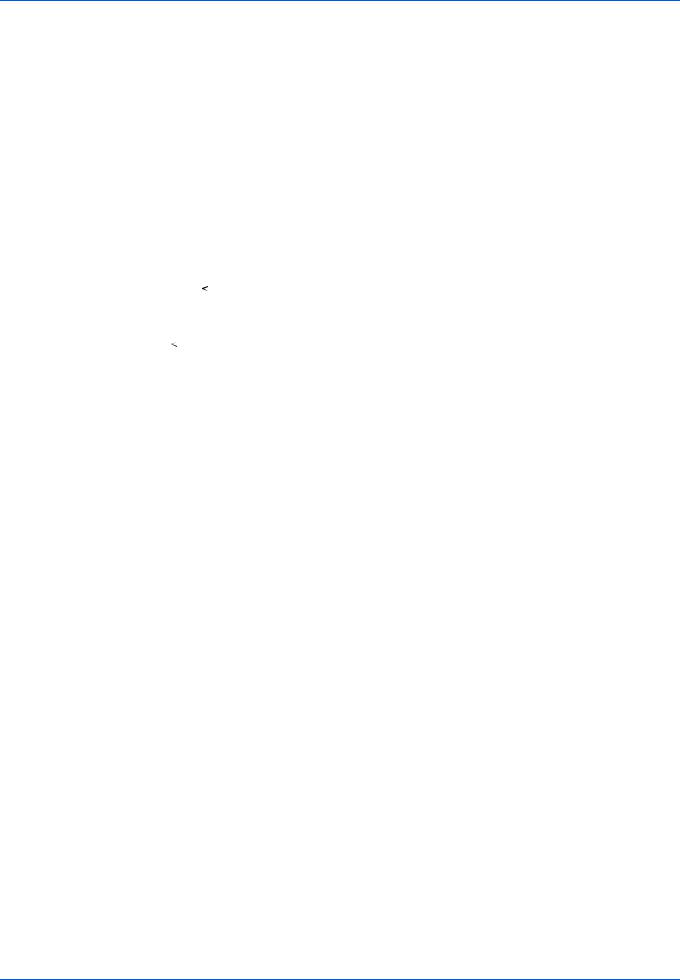
 Declarations to European Directives
Declarations to European Directives
DECLARATION OF CONFORMITY TO 2004/108/EC, 2006/95/EEC, 93/68/EEC, 1999/5/EC and 2009/125/EC
We declare under our sole responsibility that the product to which this declaration relates is in conformity with the following specifications.
Limits and methods of measurement for immunity |
EN55024 |
||||
characteristics of information technology equipment |
|
||||
Limits and methods of measurement for radio |
EN55022 Class B |
||||
interference characteristics of information technology |
|
||||
equipment |
|
||||
Limits for harmonic currents emissions for equipment |
EN61000-3-2 |
||||
input current |
|
16A per phase |
|
||
|
|
||||
Limitation of voltage fluctuations and flicker in |
EN61000-3-3 |
||||
low-voltage supply systems for equipment with rated |
|
||||
current |
|
16A |
|
||
|
|
||||
Safety of information technology equipment, including |
EN60950-1 |
||||
electrical business equipment |
|
||||
Terminal Equipment (TE); |
TBR 21 |
||||
Attachment requirements for pan-European approval |
|
||||
for connection to the analogue Public Switched |
|
||||
Telephone Networks (PSTNs) of TE (excluding TE supporting the voice telephony service) in which network addressing, if provided, is by means of Dual Tone Multi Frequency (DTMF) signalling
ix

Safety Conventions in This Guide
The sections of this guide and parts of the machine marked with symbols are safety warnings meant to protect the user, other individuals and surrounding objects, and ensure correct and safe usage of the machine. The symbols and their meanings are indicated below.
WARNING: Indicates that serious injury or even death may result from insufficient attention to or incorrect compliance with the related points.
CAUTION: Indicates that personal injury or mechanical damage may result from insufficient attention to or incorrect compliance with the related points.
The following symbols indicate that the related section includes safety warnings. Specific points of attention are indicated inside the symbol.
.... [General warning]
.... [Warning of high temperature]
The following symbols indicate that the related section includes information on prohibited actions. Specifics of the prohibited action are indicated inside the symbol.
.... [Warning of prohibited action]
.... [Disassembly prohibited]
The following symbols indicate that the related section includes information on actions which must be performed. Specifics of the required action are indicated inside the symbol.
.... [Alert of required action]
.... [Remove the power plug from the outlet]
.... [Always connect the machine to an outlet with a ground connection]
Please contact your service representative to order a replacement if the safety warnings in this Operation Guide are illegible or if the guide itself is missing. (fee required)
Note An original which resembles a bank note closely may not be copied properly in some rare cases because this machine is equipped with a counterfeiting prevention function.
x
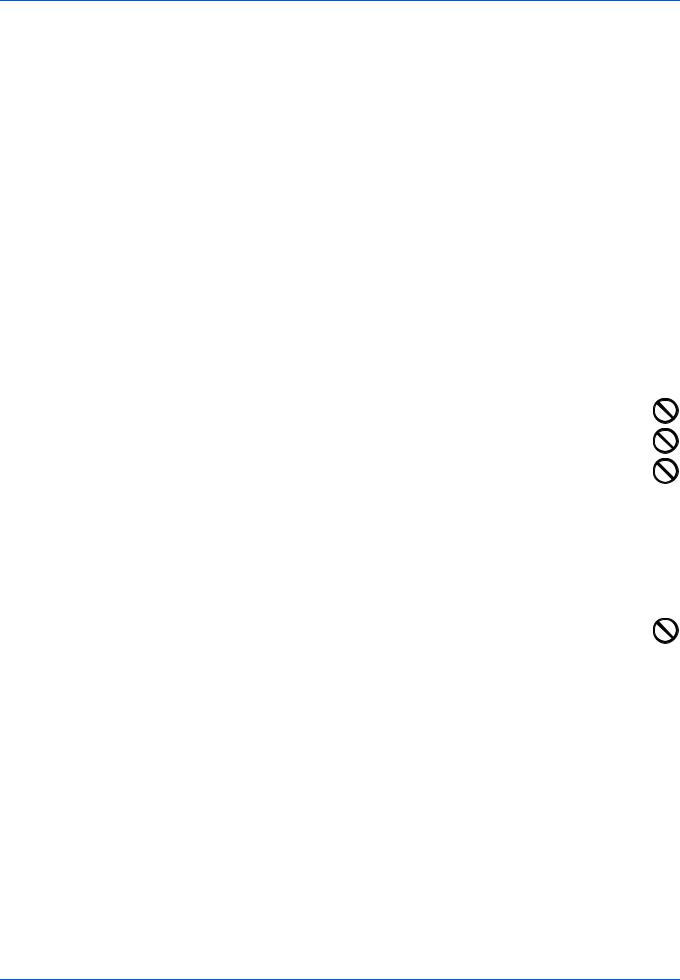
Environment
The service environmental conditions are as follows:
•Temperature: 50 to 90.5 °F (10 to 32.5 °C)
•Humidity: 15 to 80 %
However, adverse environmental conditions may affect the image quality. Avoid the following locations when selecting a site for the machine.
•Avoid locations near a window or with exposure to direct sunlight.
•Avoid locations with vibrations.
•Avoid locations with drastic temperature fluctuations.
•Avoid locations with direct exposure to hot or cold air.
•Avoid poorly ventilated locations.
If the floor is delicate against casters, when this machine is moved after installation, the floor material may be damaged.
During printing, some ozone is released, but the amount does not cause any ill effect to one’s health. If, however, the machine is used over a long period of time in a poorly ventilated room or when printing an extremely large number of copies, the smell may become unpleasant. To maintain the appropriate environment for print work, it is suggested that the room be properly ventilated.
Cautions when Handling Consumables
Do not attempt to incinerate parts which contain toner. Dangerous sparks may cause burns.
Keep parts which contain toner out of the reach of children.
If toner happens to spill from parts which contain toner, avoid inhalation and ingestion, as well as contact with your eyes and skin.
•If you do happen to inhale toner, move to a place with fresh air and gargle thoroughly with a large amount of water. If coughing develops, contact a physician.
•If you do happen to ingest toner, rinse your mouth out with water and drink 1 or 2 cups of water to dilute the contents of your stomach. If necessary, contact a physician.
•If you do happen to get toner in your eyes, flush them thoroughly with water. If there is any remaining tenderness, contact a physician.
•If toner does happen to get on your skin, wash with soap and water.
Do not attempt to force open or destroy parts which contain toner.
Other precautions
After use, always dispose of the Toner Container in accordance with Federal, State and Local rules and regulations. Store all consumables in a cool, dark location.
If the machine will not be used for an extended period of time, remove the paper from the cassette, return it to its original package and reseal it.
xi

About the Operation Guide
This Operation Guide contains the following chapters:
1 Machine Parts
This chapter lists the names of different machine parts.
2 Preparation
This chapter explains how to start up the machine, load paper and originals, and use the application software included in the Product Library disc.
3 Copying
This chapter explains the functions you can use when copying.
4 Printing
This chapter explains the printing procedure from an application software.
5 Scanning
This chapter explains the functions you can use when scanning originals.
6 Default Setting (System Menu)
This chapter explains how to use the System Menu to configure the machine.
7 FAX Operations
This chapter explains the functions you can use when faxing.
8 Maintenance
This chapter explains how to replace the toner container and how to care for your machine.
9 Troubleshooting
This chapter explains how to handle machine problems that may occur, such as paper jams.
10 Appendix
This chapter explains how to enter characters, and lists the machine specifications.
xii

Conventions in This Guide
This manual uses the following conventions.
Convention |
Description |
Example |
||
|
|
|
||
Italic Typeface |
Used to emphasize a key word, phrase |
Refer to Connections on page 2-2. |
||
|
or reference to additional information. |
|
|
|
Bold |
Used to denote buttons on the |
To start printing, click OK. |
||
|
software. |
|
|
|
Bracket Bold |
Used to denote operation panel keys. |
Press [Start] to start copying. |
||
Courier |
Indicates characters entered in the |
Ready to Copy. appears in the message display on the |
||
|
message display on the operation |
operation panel. |
||
|
panel. |
|
|
|
Note |
Used to provide additional or useful |
|
|
Note Do not remove the toner container from the |
|
information about a function or feature. |
|
|
carton until you are ready to install it in the machine. |
|
|
|
||
Important |
Used to provide important information. |
IMPORTANT Take care not to touch the drum and |
||
|
|
transfer roller (black) during cleaning. |
||
Caution |
Used to suggest mechanical damage |
CAUTION When removing a paper jam, pull the paper |
||
|
as a result of an action. |
gently so as not to tear it. Torn pieces of paper are difficult |
||
|
|
to remove and may be easily overlooked, deterring the |
||
|
|
paper jam recovery. |
||
Warning |
Used to alert users to the possibility of |
WARNING If you are shipping the machine, remove and |
||
|
personal injury. |
pack the developer unit and drum unit in a plastic bag and |
||
|
|
ship them separately from the machine. |
||
xiii

xiv

1 Machine Parts
This chapter explains the following topics: |
|
Front Machine Components.................................................................................................................................. |
1-2 |
Rear Machine Components................................................................................................................................... |
1-3 |
Operation Panel...................................................................................................................................................... |
1-4 |
1-1
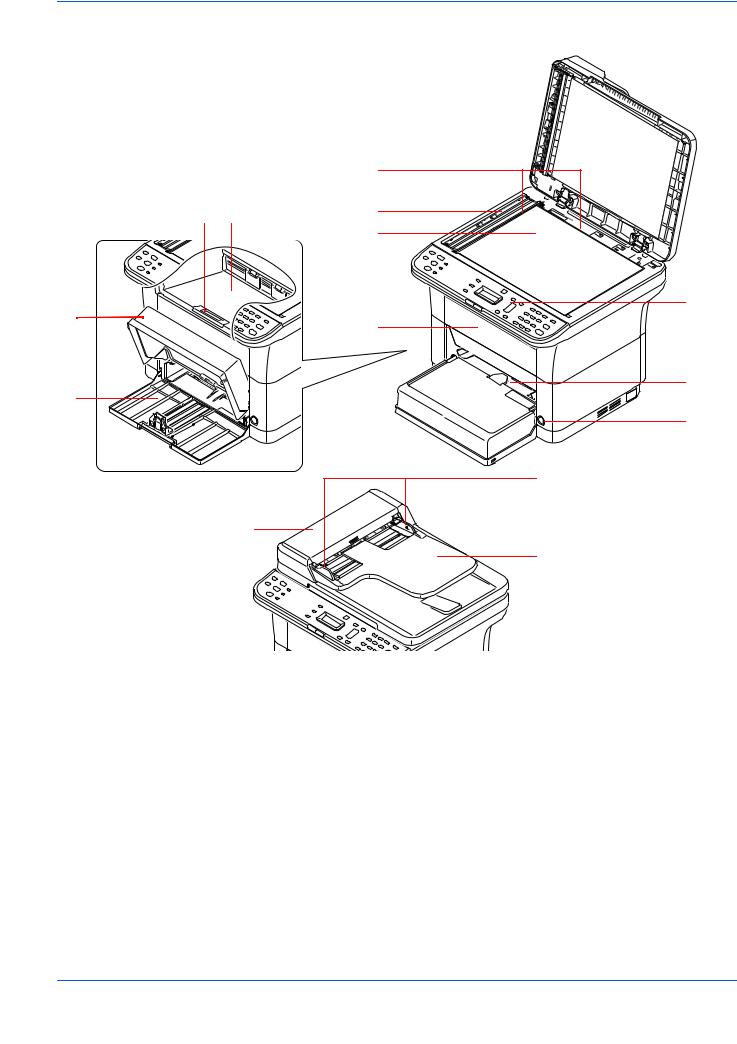
Machine Parts
Front Machine Components
|
|
1 |
5 |
6 |
2 |
|
|
3 |
7 |
9 |
|
4 |
||
|
||
8 |
10 |
|
|
||
|
11 |
|
|
13 |
|
|
12 |
|
|
14 |
1Original Size Indicator Plates
2Slit Glass
3Platen
4Front Cover
5Paper Stopper
6Inner Tray
7Cassette Cover
8Cassette
9Operation Panel
10Manual Feed Tray (FS-1025MFP, FS-1125MFP and FS-1325MFP)
11Power Switch
12Document Processor
13Original Width Guides
14Original Table
*The illustration shows the FS-1125MFP.
1-2

Machine Parts
Rear Machine Components
17
18
19
15
16
15Rear Cover
16Power Cord Connector
17USB Interface Connector
18Network Interface Connector (FS-1025MFP, FS-1125MFP and FS-1325MFP)
19LINE Connector (FS-1120MFP, FS-1125MFP, FS-1320MFP and FS-1325MFP)
*The illustration shows the FS-1125MFP.
1-3

Machine Parts
Operation Panel
[Copy] key |
|
Displays the Copy screen. |
|||||
[Scan] key |
|
Displays the Scan screen. |
|||||
|
|
|
|
|
|
||
[FAX] key* |
|
Displays the FAX screen. |
|||||
|
|
|
|
|
|
||
[Print Box] key |
|
Displays the Print Box screen. |
|||||
|
|
|
|
|
|
||
[ID Card Copy] key |
|
Displays the ID Card Copy |
|||||
|
|
|
|
screen. |
|||
[Address Book] key* |
|
Displays the Address Book |
|||||
|
|
|
|
screen, where you can add |
|||
|
|
|
|
destinations. |
|||
|
|
|
|
|
|
||
[Address |
|
Calls the previous destination. |
|||||
Recall/Pause] key* |
|
Also used to enter a pause |
|||||
|
|
|
|
when entering a FAX number. |
|||
|
|
|
|
|
|
||
[On Hook] key* |
|
Switches between on-hook |
|||||
|
|
|
|
and off-hook when manually |
|||
|
|
|
|
sending a FAX. |
|||
|
|
* Only on the FS-1120MFP, |
|||||
|
|
|
FS-1125MFP, FS-1320MFP and |
||||
|
|
|
FS-1325MFP. |
||||
|
|
|
|
|
|
|
|
|
|
|
|
|
|
|
|
|
|
|
|
|
|
|
|
|
|
|
|
|
|
|
|
|
|
|
|
|
|
|
|
|
|
|
|
|
|
|
|
|
|
|
|
|
|
|
|
|
|
|
|
|
|
|
|
[Menu] key |
|
|
Displays functions and the System |
||||||||
|
|
|
|
|
Menu. |
||||||
|
|
|
|
|
|||||||
[Density] key |
|
|
Displays the density setting screen. |
||||||||
|
|
|
|
|
|||||||
[] key / [] key |
|
|
Increments or decrements numbers, |
||||||||
|
|
|
|
|
or selects menu in the message |
||||||
|
|
|
|
|
display. In addition, moves the cursor |
||||||
|
|
|
|
|
when entering the characters. |
||||||
|
|
|
|
|
|||||||
[Back] key |
|
|
Returns to the previous display. |
||||||||
|
|
|
|
|
|||||||
[OK] key |
|
|
Finalizes a function or menu, and |
||||||||
|
|
|
|
|
numbers that have been entered. |
||||||
|
|
|
|
|
|
|
|
|
|
|
|
|
|
|
|
|
|
|
|
|
|
|
|
|
|
|
|
|
|
|
|
|
|
|
|
|
|
|
|
|
|
|
|
|
|
|
|
|
|
|
|
|
|
|
|
|
|
|
|
|
|
|
|
|
|
|
|
|
|
|
|
|
|
|
|
|
|
|
|
|
|
|
|
|
|
|
|
|
|
|
|
|
|
|
|
|
|
|
|
|
|
[Program 1] - |
|
Calls up the settings that |
|
|
|
||||
[Program 3] |
|
are registered in [Program |
|
|
|
||||
key |
|
1] - [Program 3]. |
|
|
|
||||
|
|
|
|
|
|
|
|
|
|
[Quiet Mode] key |
Turns on Quiet Mode. |
||||||||
|
|
|
|
|
Quiet Mode |
||||
|
|
|
|
|
If you prefer quiet operation, |
||||
|
|
|
|
|
press [Quiet Mode] to turn on |
||||
|
|
|
|
|
Quiet Mode. When Quiet Mode |
||||
|
|
|
|
|
is on, the print speed is slower. |
||||
|
|
|
|
|
|
|
|||
Message Display |
Displays the setting menu, |
||||||||
|
|
|
|
|
machine status, and error |
||||
|
|
|
|
|
messages. |
||||
|
|
|
|
|
|
|
|
||
Processing |
|
Flashing |
The machine is processing data. |
||||||
Indicator |
|
|
|
|
|
|
|
|
|
|
Very slow |
The machine is in sleep mode. |
|||||||
(Green) |
|
||||||||
|
(5-second |
|
|
|
|
|
|||
|
|
|
|
|
|
|
|||
|
|
interval) |
|
|
|
|
|
||
|
|
flashing |
|
|
|
|
|
||
|
|
|
|
|
|
|
|
||
Attention Indicator |
Lights or flashes when an error |
||||||||
(Amber) |
|
|
|
occurs. |
|||||
Numeric keys |
Enter numbers and symbols. |
|
|
[Clear] key |
Clears entered numbers and |
|
characters. |
|
|
[Stop/Reset] key |
• Cancels the printing job in |
|
progress. |
|
• Returns settings to their |
|
default states. |
|
• Hold down two seconds to |
|
pause printing. Hold down |
|
two seconds again to |
|
resume printing. |
|
|
[Start] key |
Starts copying, scanning, and |
|
FAX transmission operations. |
1-4

2 |
Preparation |
|
|
|
|
This chapter explains the following topics: |
|
|
Connections ........................................................................................................................................................... |
2-2 |
|
Loading Paper ........................................................................................................................................................ |
2-5 |
|
Loading Originals................................................................................................................................................. |
2-18 |
|
Installing and Uninstalling Drivers and Utilities................................................................................................ |
2-20 |
|
Machine Settings.................................................................................................................................................. |
2-26 |
|
Configuration........................................................................................................................................................ |
2-48 |
|
Printing the Status Page...................................................................................................................................... |
2-58 |
|
2-1

Preparation
Connections
This section explains how to start up the machine.
Connecting the USB Cable
Follow the steps as below for connecting the USB cable.
1 Connect the USB cable to the machine’s USB interface connector.
Note Use a USB cable with a rectangular Type A plug and a square Type B plug. The USB cable should be shielded and no longer than 5 meters (16 feet) long.
2 Connect the other end of the USB cable to the computer's USB interface connector.
Connecting the Network Cable (FS-1025MFP, FS-1125MFP and FS-1325MFP)
Follow the steps as below for connecting the network cable.
1Connect the network cable (not included) to the machine’s network interface connector.
2Connect the other end of the cable to the PC or your network device.
 Note Use shielded interface cables.
Note Use shielded interface cables.
2-2
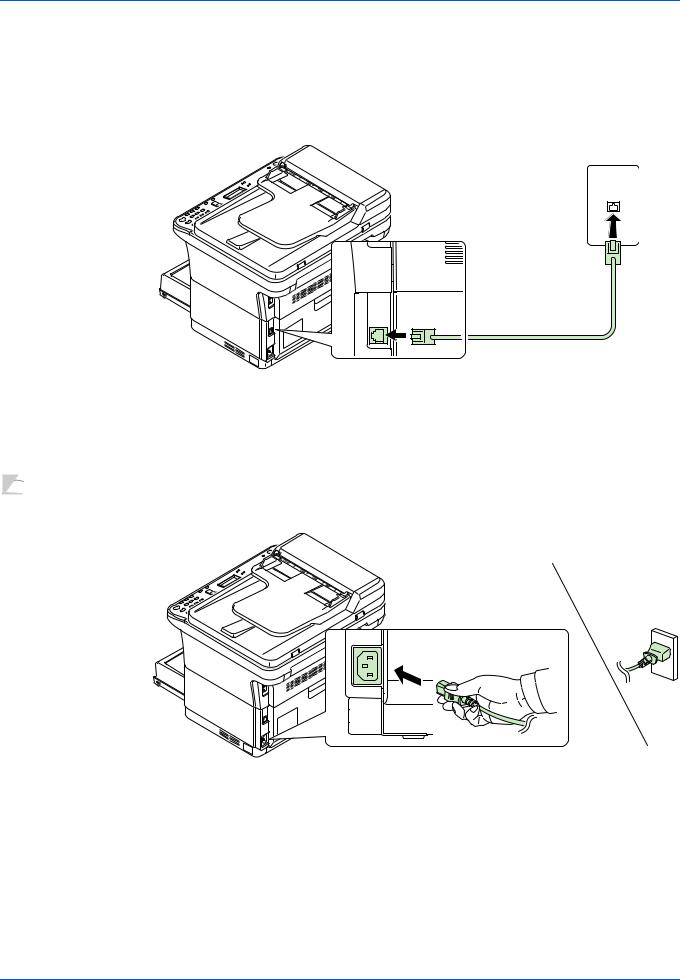
Preparation
Connecting the FAX Modular Cord (FS-1120MFP, FS-1125MFP, FS-1320MFP and
FS-1325MFP)
Follow the steps as below for connecting the modular cord.
1Connect the modular cord for the telephone line to LINE connector.
2Connect the other end of the modular cord to the modular jack.
Connecting the Power Cord
Install the machine close to an AC wall outlet. If an extension cord is used, the total length of the power cord plus extension should be 5 meters (16 feet) or less.
 Note Only use the power cord supplied with the machine.
Note Only use the power cord supplied with the machine.
1 Connect the power cord to the power cord connector at the rear of the machine.
2 Connect the other end of the power cord to a power outlet.
2-3
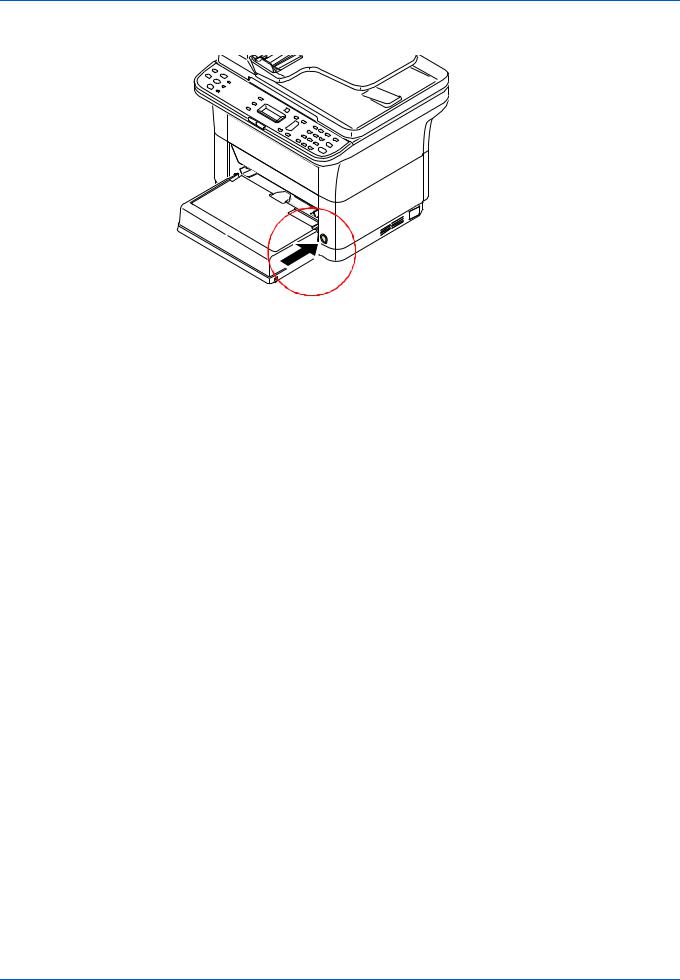
Preparation
3 Press the power switch to On. The machine begins to warm up.
IMPORTANT If you install the toner container and switch on the power, the start-up screen (a rotating bar image) and then Adding toner... will be displayed on the message display. When the machine is first switched on after toner installation, there will be a delay of approximately 7 minutes before the machine gets ready to use. When Ready to copy. appears in the message display on the operation panel, machine installation is complete.
Starter Toner Container
The toner container packed with the new machine is a starter toner container. The starter toner container lasts an average of 700 pages (FS-1120MFP and FS-1320MFP) or 1,000 pages (FS-1025MFP, FS-1125MFP and FS-1325MFP).
2-4

Preparation
Loading Paper
General Guidelines
The machine is designed to print on standard copier paper, but it can also accept a variety of other types of paper within the limits specified below.
Note The manufacturer assumes no liability for problems that occur when paper not satisfying these requirements is used.
Selection of the right paper is important. Using the wrong paper can result in paper jams, curling, poor print quality, and paper waste, and in extreme cases can damage the machine. The guidelines given below will increase the productivity of your office by ensuring efficient, trouble-free printing and reducing wear and tear on the machine.
Paper Availability
Most types of paper are compatible with a variety of machines. Paper intended for xerographic copiers can also be used with the machine.
There are three general grades of paper: economy, standard, and premium. The most significant difference between grades is the ease with which they pass through the machine. This is affected by the smoothness, size, and moisture content of the paper, and the way in which the paper is cut. The higher the grade of paper you use, the less risk there will be of paper jams and other problems, and the higher the level of quality your printed output will reflect.
Differences between paper from different suppliers can also affect the machine's performance. A high-quality machine cannot produce high-quality results when the wrong paper is used. Low-priced paper is not economical in the long run if it causes printing problems.
Paper in each grade is available in a range of basis weights (defined later). The traditional standard weights are 60 to 120 g/m² (16 to 31.9b).
Paper Specifications
The following table summarizes the basic paper specifications. Details are given on the following pages:
Item |
Specifications |
|
|
Weight |
Cassette: 60 to 220 g/m² (16 to 58.5 lb/ream) |
|
Manual Feed tray: 60 to 220 g/m² (16 to 58.5 lb/ream) |
|
|
Thickness |
0.086 to 0.110 mm (3.4 to 4.3 mils) |
|
|
Dimensional Accuracy |
±0.7 mm (±0.0276 inches) |
|
|
Squareness of Corners |
90 ±0.2° |
|
|
Moisture Content |
4 to 6% |
|
|
Pulp Content |
80% or more |
|
|
2-5

Preparation
Minimum and Maximum Paper Sizes
The minimum and maximum paper sizes are as follows. Cassette
|
|
|
|
|
inches) |
|
|
|
|
Minimum |
|
|
|
|
|
|
|
|
|
|
|
|
|
|
|||
|
|
|
|
|
|
|
|
|
|
|
|
||
|
|
|
|
(5-13/16 |
|
|
|
Paper Size |
|
|
|||
|
|
|
|
|
|
|
|
|
|
|
|
||
inches) |
|
|
148 mm |
|
|
|
|
|
|
|
|
||
|
|
|
|
|
|
|
|
||||||
|
|
|
|
|
|
|
|
|
|
||||
|
|
|
|
|
|
|
|
|
|
||||
|
|
|
|
|
|
|
|
|
|
||||
(14 |
|
|
|
|
|
|
|
|
|
70 mm |
|
||
|
|
|
|
|
|
|
(2-3/4 inches) |
|
|||||
356 mm |
|
|
|
|
|
|
|
||||||
|
|
|
|
|
|
Maximum |
|
||||||
|
|
|
|
|
|
|
|
|
|
||||
|
|
|
|
|
|
|
|
|
Paper Size |
|
|||
|
|
|
|
|
|
|
|
|
|
|
|
|
|
|
|
|
|
|
|
|
|
|
|
|
|
|
|
|
|
|
|
|
|
|
|
|
|
|
|
|
|
356 mm (14 inches)
Manual Feed Tray
inches) |
|
|
|
Minimum |
|
||
|
|
|
|||||
|
|
|
|
|
|
||
(5-13/16 |
|
|
|
Paper Size |
|
||
|
|
|
|
|
|
|
|
148 mm |
|
|
|
|
|
|
|
|
|
|
|
|
|
|
|
|
|
|
|
|
|
|
|
|
|
|
|
|
|
|
|
|
|
|
|
|
|
|
|
70 mm (2-3/4 inches)
Maximum
Paper Size
|
|
|
|
|
|
216 mm (8-1/2 inches) |
|
|
|
|
216 mm (8-1/2 inches) |
|
|
Selecting the Right Paper
This section describes the guidelines for selecting paper.
Condition
Avoid using paper that is bent at the edges, curled, dirty, torn, embossed, or contaminated with lint, clay, or paper shreds.
Use of paper in these conditions can lead to illegible printing and paper jams, and can shorten the life of the machine. In particular, avoid using paper with a surface coating or other surface treatment. Paper should have as smooth and even a surface as possible.
Composition
Do not use paper that has been coated or surface-treated and contains plastic or carbon. The heat of fusing can cause such paper to give off harmful fumes.
Bond paper should contain at least 80% pulp. Not more than 20% of the total paper content should consist of cotton or other fibers.
Paper Sizes
Cassette and the Manual Feed tray are available for the paper sizes shown below. The dimensional tolerances are ±0.7mm for the length and width. The angle at the corners must be 90° ±0.2°.
•A4 (210 × 297 mm)
•A5 (148 × 210 mm)
•A6 (105 × 148 mm)
•Folio (210 × 330 mm)
•JIS B5 (182 × 257 mm)
•ISO B5 (176 × 250 mm)
•Letter (8-1/2 × 11 inches)
•Legal (8-1/2 × 14 inches)
2-6

Preparation
•Statement (5-1/2 × 8-1/2 inches)
•Executive (7-1/4 × 10-1/2 inches)
•Envelope Monarch (3-7/8 × 7-1/2 inches)
•Envelope #10 (4-1/8 × 9-1/2 inches)
•Envelope #9 (3-7/8 × 8-7/8 inches)
•Envelope #6-3/4 (3-5/8 × 6-1/2 inches)
•Envelope C5 (162 × 229 mm)
•Envelope DL (110 × 220 mm)
•Oficio II (216 × 340 mm, 8-1/2 × 13 inches)
•216 × 340 mm
•16 K (197 × 273 mm)
•Custom*
70 × 148 to 216 × 356 mm, 2-3/4 × 5-13/16 to 8-1/2 × 14 inches
*If the length of custom paper is larger than 297 mm (11-11/16 inches), the machine can be substituted A4, Folio, Legal, and Oficio II as the standard paper size.
Smoothness
The paper should have a smooth, uncoated surface. Paper with a rough or sandy surface can cause blank spaces in the printed output. Paper that is too smooth can cause multiple feeding and fogging problems. (Fogging is a gray background effect.)
Basis weight
Basis weight is the weight of paper expressed in grams per square meter (g/m²). Paper that is too heavy or too light may cause feed errors or paper jams as well as premature wear of the product. Uneven weight of paper, namely uneven paper thickness may cause multiple-sheet feeding or print quality problems such as blurring because of poor toner fusing.
The recommended basis weight is between 60 and 220 g/m² (16 to 58.5 lib/ream).
Paper Weight Equivalence Table
The paper weight is listed in pounds (lb) and metric grams per square meter (g/m²). The shaded part indicates the standard weight.
Europe Metric Weight |
U. S. Bond Weight (lb) |
Europe Metric Weight |
U. S. Bond Weight (lb) |
|
(g/m²) |
(g/m²) |
|||
|
|
|||
|
|
|
|
|
60 |
16 |
128 |
34 |
|
64 |
17 |
135 |
36 |
|
75 |
20 |
148 |
39 |
|
80 |
21 |
157 |
42 |
|
81 |
22 |
163 |
43 |
|
|
|
|
|
|
90 |
24 |
176 |
47 |
|
100 |
27 |
199 |
53 |
|
105 |
28 |
220 |
58.5 |
|
120 |
32 |
|
|
|
|
|
|
|
Thickness
The paper used with the machine should be neither extremely thick nor extremely thin. If you are having problems with paper jams, multiple feeds, and faint printing, the paper you are using may be too thin. If you are having problems with paper jams and blurred printing the paper may be too thick. The correct thickness is 0.086 to 0.110 mm (3.4 to 4.3 mils).
2-7

Preparation
Moisture Content
Moisture content is defined as the percent ratio of moisture to the dry mass of the paper. Moisture can affect the paper’s appearance, feed ability, curl, electrostatic properties, and toner fusing characteristics.
The moisture content of the paper varies with the relative humidity in the room. When the relative humidity is high and the paper absorbs moisture, the paper edges expand, becoming wavy in appearance. When the relative humidity is low and the paper loses moisture, the edges shrink and tighten, and print contrast may suffer.
Wavy or tight edges can cause jams and alignment anomalies. The moisture content of the paper should be 4 to 6%.
To ensure correct moisture content, it is important to store the paper in a controlled environment. Some tips on moisture control are:
•Store paper in a cool, dry location.
•Keep the paper in its wrapping as long as possible. Re-wrap paper that is not in use.
•Store paper in its original carton. Place a pallet etc. under the carton to separate it from the floor.
•After removing paper from storage, let it stand in the same room as the machine for 48 hours before use.
•Avoid leaving paper where it is exposed to heat, sunlight, or damp.
Other Paper Properties
Porosity: Indicates the density of paper fiber.
Stiffness: Limp paper may buckle in the machine, resulting in paper jams.
Curl: Most paper naturally tends to curl one way if left unpacked. When paper passes through the fixing unit, it curls upward a little. To produce flat printouts, load the paper so that the upward pressure from the machine can correct their curling.
Electrostatic discharge: During the printing process the paper is electrostatically charged to attract the toner. The paper must be able to release this charge so that printed sheets do not cling together in the Output Tray.
Whiteness: The contrast of the printed page depends on the whiteness of the paper. Whiter paper provides a sharper, brighter appearance.
Quality control: Uneven sheet size, corners that are not square, ragged edges, welded (uncut) sheets, and crushed edges and corners can cause the machine to malfunction in various ways. A quality paper supplier should take considerable care to ensure that these problems do not occur.
Packaging: Paper should be packed in a sturdy carton to protect it from damage during transport. Quality paper obtained from a reputable supplier is usually correctly packaged.
Specially treated paper: We do not recommend printing onto the following types of paper, even if it conforms to the basic specifications. When you use these kinds of paper, purchase a small amount first as a sample to test.
•Glossy paper
•Watermarked paper
•Paper with an uneven surface
•Perforated paper
2-8
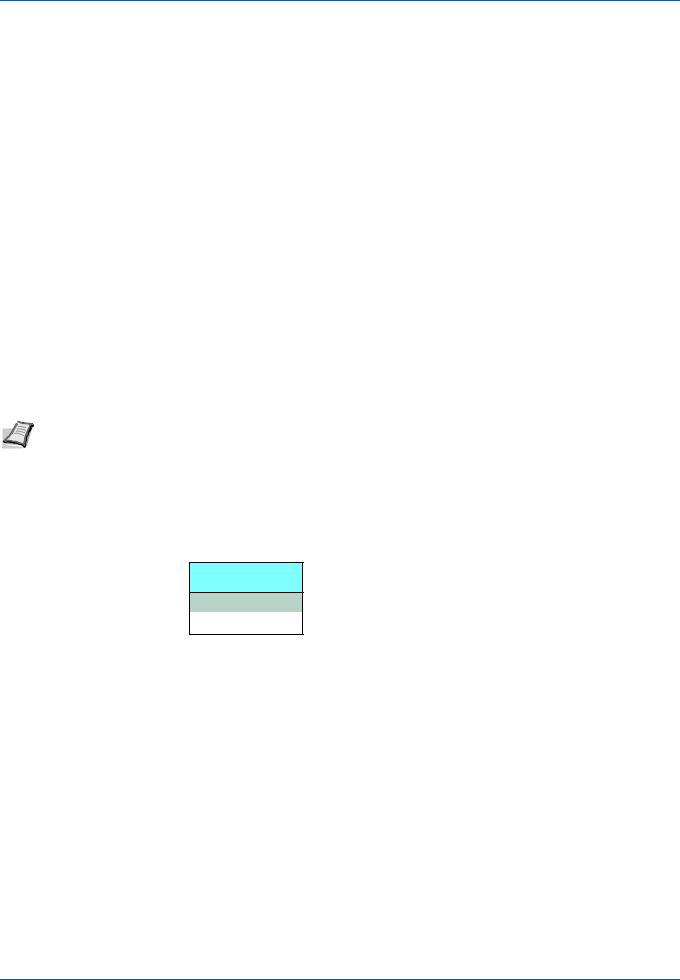
Preparation
Special Paper
The following types of special paper can be used:
•Preprinted paper
•Labels*
•Bond paper
•Recycled paper
•Thin paper* (60 to 64 g/m²)
•Rough paper
•Letterhead
•Colored paper
•Prepunched paper
•Envelopes*
•Cardstocks (Postcards)*
•Thick paper (90 to 220 g/m²)
•High-quality paper
*Only one sheet can be loaded at a time in the cassette or in the Manual Feed tray. Use paper that is sold specifically for use with copiers or printers (heat-fusing type).
Since the composition and quality of special paper vary considerably, special paper is more likely than white bond paper to give trouble during printing. No liability will be assumed if moisture and so forth given off during printing on special paper causes harm to the machine or operator.
Note Before purchasing any type of special paper, test a sample on the machine and check that printing quality is satisfactory.
Labels
One label sheet can be loaded at a time.
The basic rule for printing on adhesive labels is that the adhesive must never come into contact with any part of the machine. Adhesive paper sticking to the drum or rollers will damage the machine.
Top sheet (white bond paper)
Adhesive
 Carrier sheet
Carrier sheet
Label paper has a structure comprising of three layers, as shown in the diagram. The top sheet is printed on. The adhesive layer consists of pressure-sensitive adhesives. The carrier sheet (also called the linear or backing sheet) holds the labels until used. Due to the complexity of its composition, adhesive-backed label paper is particularly likely to give printing problems.
Adhesive label paper must be entirely covered by its top sheet, with no spaces between the individual labels. Labels with spaces in between are liable to peel off, causing serious paper jam problems.
2-9

Preparation
Some label paper is manufactured with an extra margin of top sheet around the edge. Do not remove the extra top sheet from the carrier sheet until after printing is finished.
Acceptable |
Unacceptable |
 Top sheet
Top sheet 

Carrier sheet 
The table below lists the specifications for adhesive label paper.
Item |
Specification |
|
|
Weight of top sheet |
44 to 74 g/m² (12 to 20 lb/ream) |
|
|
Composite weight |
104 to 151 g/m² (28 to 40 lb/ream) |
|
|
Thickness of top sheet |
0.086 to 0.107 mm (3.9 to 4.2 mils) |
|
|
Composite thickness |
0.115 to 0.145 mm (4.5 to 5.7 mils) |
|
|
Moisture content |
4 to 6% (composite) |
|
|
Postcards
One postcard can be loaded at a time. Make sure the postcards you are going to set are not curled. Feeding curled postcards may cause paper jams.
Some postcards have rough edges on the back (those are created when the paper is cut). In this case, put the postcard on a flat place and rub the edges with, for example, a ruler to smooth them.
Envelopes
One envelope can be loaded at a time. Envelopes should be fed in the face-up position, right edge first.
Since the composition of an envelope is more complex than that of ordinary paper, it is not always possible to ensure consistent printing quality over the entire envelope surface.
Normally, envelopes have a diagonal grain direction. This direction can easily cause wrinkles and creases when envelopes pass through the machine. Before purchasing envelopes, make a test print to check whether the machine accepts the envelope.
•Do not use envelopes that have an encapsulated liquid adhesive.
•Avoid a long printing session for envelopes only. Extended envelope printing can cause premature machine wear.
2-10
